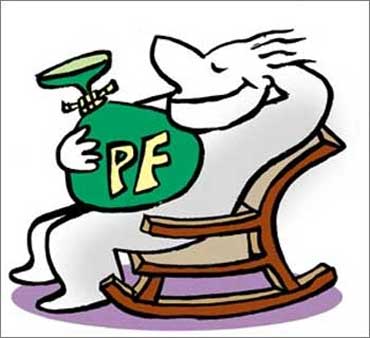Photographs: Uttam Ghosh/Rediff.com Kundan Kishore, Outlook Money
By now you would be having a fair idea as to how much have you committed under Section 80C. As the maximum investment limit under Section 80C is Rs 1 lakh (Rs 100,000), let us see what other tax-saving products are available to utilise this limit to the fullest.
There is a plethora of tax-saving products that come with varied duration, interest rates and taxability. However, one of the most important factors that decide the suitability of a product for you is the level of risk it comes laden with.
So, whatever your risk appetite be (low, medium or high), there are products to choose from. On the one end of the scale are fixed income tax-fee instruments, such as Public Provident Fund (PPF).
On the other end are market-linked products, including equity-linked savings schemes (ELSS). And there are others in between.
Remember, as a salaried employee, 12 per cent of your basic salary finds it way into debt assets, such as Employees Provident Fund (EPF).
. . .
Here are some great tax-saving schemes
Photographs: Uttam Ghosh/Rediff.com
Even if you do not take this into account, the asset mix for your take-home income should be such that you give adequate time for assets, such as equities, to work in your favour.
Ideally, those who have the luxury of time in achieving their long-term goals can have an equity-debt mix of 70:30. Those nearing their goals can stay put at 30:70 or even 20:80.
Making the choice
Tax-saving products are available for almost all age groups and risk profiles. In addition to differentiating factors such as duration, interest rates and taxability, liquidity and commitment towards future payouts are also important things to consider.
Another way to look at them is to consider their returns -- fixed and assured returns, and market-linked returns.
Whatever be the nature of returns you plan to choose, there are two things that you must keep in mind: your portfolio's equity-debt mix and linking the investment to your goals.
. . .
Here are some great tax-saving schemes
Photographs: Uttam Ghosh/Rediff.com
While choosing any tax-saving investments, do not skew your portfolio mix or distort your portfolio towards any specific asset class.
Similarly, select the product that helps you achieve your long-term financial goals rather than just save tax for the year.
And, above all, keep the impact of inflation on the radar while zeroing down on any of these investments.
What's on the menu
Within the basket of Section 80C investments, you can choose among products that give fixed and assured returns (low-risk), and products whose returns are not fixed but linked to the market (medium- and high-risk).
Low-risk options
Options for those looking for fixed and assured returns are plenty.
The basket comes with options such as notified bank fixed deposits (for a period of five years), life insurance plans (pure term and endowment), Public Provident Fund (PPF), National Savings Certificate (NSC) and Senior Citizens Savings Scheme (SCSS), among others. All such schemes fall under the low-risk category.
. . .
Here are some great tax-saving schemes
Photographs: Uttam Ghosh/Rediff.com
Senior Citizens Savings Scheme
As the name suggests, this scheme is only for those who are above the age of 60. Only retirement proceeds can be invested in these schemes. Early retirees can invest in SCSS, provided they do so within three months of receiving their retirement proceeds.
The scheme can be availed from a post office or a bank, and it offers the highest post-tax returns among all taxable products for a period of five years, at 9 per cent.
The upper investment limit in the scheme is Rs 15 lakh (Rs 1.5 million) and the interest is payable quarterly and is fully taxable.
The scheme is a must-have for all retirees in order to form a base income to meet their monthly household needs.
Bank deposits
For those who are less than 60 years old and self-employed, the five-year bank tax-saver is the next pit stop.
. . .
Here are some great tax-saving schemes
Photographs: Uttam Ghosh/Rediff.com
In addition to giving you fixed and assured returns, these tax- savers also come with the tax advantage. A bank deposit is a one-time investment and there is no commitment to pay in the future.
IDBI Bank and ICICI Bank currently offer interest of 8 per cent per annum over five years. Remember, the entire interest income from such deposits is taxable.
Public Provident Fund
This is a self-directed investment option and can be opened by any salaried or non-salaried individual in any specified bank or post office.
It is a 15-year investment that currently carries a tax-free interest rate of 8 per cent. The rate is subject to change every April.
You don't have to pay a fixed sum every year, any amount between Rs 500 and Rs 70,000 keeps the account active. The pre-tax yield of PPF is the highest amongst all fixed income instruments.
. . .
Here are some great tax-saving schemes
Photographs: Uttam Ghosh/Rediff.com
National Savings Certificate (NSC)
Those who are risk-averse can opt for this option. This government-backed security is available at post offices and comes with an interest rate of 8 per cent, compounded half-yearly.
The interest is entirely taxable and has an investment horizon of six years.
Market-linked returns
Here, one may choose from pension mutual fund schemes under the medium-risk category, or equity-linked savings schemes (ELSS) of mutual funds and unit-linked insurance plans (Ulips) under the high-risk category.
Medium-risk options
If, along with saving taxes, you want to invest towards retirement, pension funds could come in handy. Even investors with a moderate risk appetite can go for pension funds.
There are two pension schemes offered by the two fund houses: UTI-Retirement Benefit Pension (RBP) Fund by UTI Mutual Fund and Templeton India Pension Plan (TIPP) by Franklin Templeton. Both these schemes are hybrid products (a combination of equity and debt).
. . .
Here are some great tax-saving schemes
Photographs: Uttam Ghosh/Rediff.com
Usually, a pension fund invests 60 per cent of its corpus into debt and the remaining 40 per cent in equity instruments.
With pension funds, you can invest as little as Rs 500 every month. A unitholder has to ensure that he invests an aggregate sum of at least Rs 10,000 before he completes 52 years of age for UTI-RBP.
In case of TIPP, however, an investor has to make a minimum investment of Rs 10,000 by the time he reaches the age of 58.
UTI-RBP allws you to withdraw your money any time after the stipulated lock-in period of three years, but you need to maintain a minimum balance of Rs 10,000 in the folio till the age of 52 years.
In case of TIPP, investors can redeem a minimum amount of Rs 1,000, subject to a three-year lock-in period from the date of investment. An investor can withdraw his full holdings after reaching the age of 58.
. . .
Here are some great tax-saving schemes
This gives him the opportunity to redeem his investment after three years, but in this case, he would need to pay an exit load, which is 3 per cent of the corpus.
TIPP is a part of OLM 50 -- Outlook Money's list of choicest schemes across categories. Consistency in performance is the hallmark of the fund and, therefore, it enjoys a 4-star rating by Outlook Money.
High-risk options
ELSS
This is a type of mutual fund which routes investments to the equity market. It differs from other mutual funds in that it carries a tax benefit on the amount invested and has a three-year lock-in period for funds invested.
Any income in the form of dividends received from such equity funds is tax-free in the hands of the investor.
Even the long-term capital gains arising from the transfer of such units of an equity-oriented fund are exempted under Section 10(38) of the Income Tax Act.
. . .
Here are some great tax-saving schemes
Photographs: Uttam Ghosh/Rediff.com
If the performance of the scheme has been good and you do not need money, funds need not be withdrawn after the end of the three-year lock-in period. Instead, you can remain invested for a longer period of five years or more.
Unit-linked insurance plans
A unit-linked insurance plan (Ulip) is a market-linked life insurance plan that combines both investment and protection.
The premiums that you pay not just provide you with life insurance, but part of them are also invested in investment funds of your choice.
As a policyholder, you can choose the allocation of your insurance premiums towards protection and investment. Link your goal to the Ulip, be it for children's education or marriage, or any other long-term objective.
Choose between Type I Ulips (where death benefit is higher of sum assured and fund value) and Type II Ulips (where both sum assured and fund value are paid on death).
. . .
Here are some great tax-saving schemes
Photographs: Reuters
Ulips serve you best if they are run for a longer duration -- at least 10 years. Any early exit could prove to be expensive.
If you had begun tax planning for this year around April, you are probably on the right path. For those who did not, now is the right time.
Finally, even after you have made investments and claimed tax breaks, do not forget to keep the records and documents of your investments and tax deduction certificates as you would need to furnish them to your employer very soon.












article